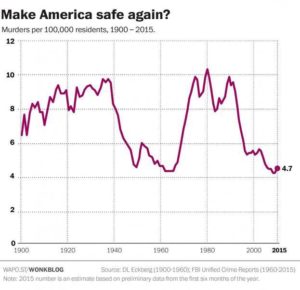Steve Sailer writes: But take a look at the single most dominant notable feature of the graph: the huge increase in murders in the second half of the 1960s and the first half of the 1970s when liberals took charge of the criminal justice system:
Wow.
It might make you think twice about the new Abolish Mass Incarceration conventional wisdom whose rise has coincided (perhaps not coincidently) with the 17% increase in homicides seen in the 50 biggest cities in 2015 over 2014.
COMMENTS:
* I would love to see a similar graph for attempted murders (shootings, stabbings, etc) per 100,000 males aged 15-35. The picture would not look so rosy then, especially in comparison to the early 1900′s when a much larger percentage of the population consisted of young males and differences in medical care and evac, etc. meant that you were much more likely to die when shot.
* It may be new to millennials, but the conventional wisdom for the last four decades been that the spike in crime from c. 1965 to c. 1971 coincided with the institution of Great Society welfare programs that underwrote mass migration of the rural poor to inner cities.
What’s new here?
On the other hand, it might be worth a second look so that we can find less boring, more sophisticated causal explanations.
For instance, a typical movie in 1965 was ‘The Sound of Music.’ In 1971, ‘The French Connection’. In between those two points, movies steadily became more and more violent, starting with a ‘A Fistful of Dollars.’ People must have streamed out of movie theaters, increasingly surly and worked up, resulting in the spike in crime.
More seriously, this is the third time in three weeks that I’ve scoured the nets in vain for an article I saw that correlated the number of young black men swept up and incarcerated from the streets of New York City with the drop in crime rates during the Giuliani administration. Anyone?
* I remember reading some amazing facts about incarceration in Kansas in the 70s in Bill James’s book Popular Crime. It began with murderers being considered for parole after seven years. From there, the possibility of being released on parole became an automatic right if the convict had done nothing wrong in prison. But the craziest part was that the period spent awaiting trial was counted as time served – even if the murderer had been out on bail. So if a killer could get bail and delay his trial for as long as possible, serving four years for murder would be a realistic prospect.

